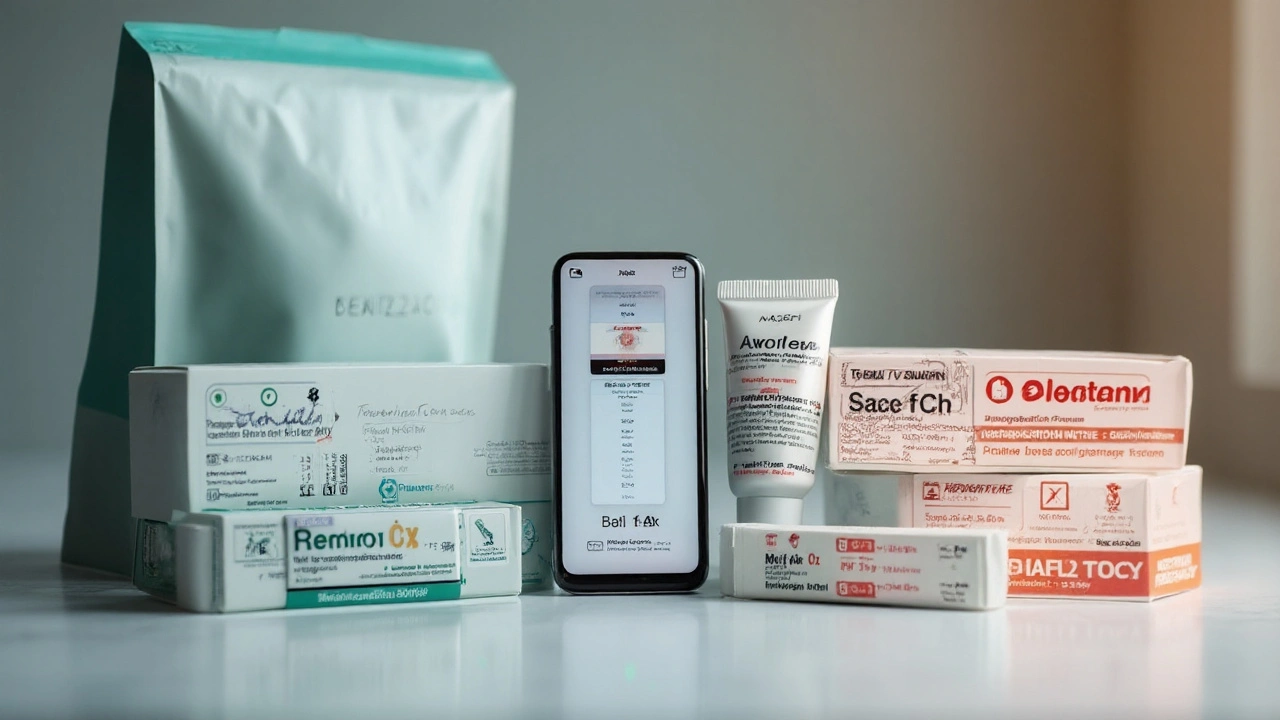Tretinoin works. It clears acne, softens fine lines, and evens tone. The hard part is getting it online without wasting money or risking sketchy knockoffs. Here’s how to buy tretinoin online in 2025 the right way-legal routes only, real prices, fast steps, and the safety checks I use as a busy dad who doesn’t have time for clinic waiting rooms.
- Yes, tretinoin is prescription-only in the US, UK, Canada, EU, and Australia. Real sites require a valid script or offer a telehealth visit.
- Fastest path: a telederm visit (5-15 minutes of questions + photos), e‑prescription, then mail delivery from an accredited pharmacy.
- Typical price: US $20-$60 for generic (45 g), UK £19-£39 private, CA CAD $25-$70, AU AUD $25-$60, EU €20-€50. Consults run $/£/€15-60.
- Start with 0.025% cream if you’re new or sensitive; order a 20-45 g tube. Use a pea-size at night, 2-3 nights/week, then build up.
- Red flags: “no prescription needed,” no license number, no pharmacist support, prices that seem unreal, or unsealed/foreign-labeled tubes.
What You Can Actually Buy Online (Legal and Safe)
Tretinoin is a prescription retinoid. It’s FDA-approved for acne in the US and similarly regulated by MHRA (UK), Health Canada, the European Medicines Agency network, and Australia’s TGA. That means every legitimate online path involves a prescription-either one you already have or one you get through a licensed clinician via telemedicine. Sites that skip this step are cutting corners you don’t want near your face.
What about countries where topical retinoids can be found over the counter? You’ll see claims about Mexico or India. Importing prescription medicines without a prescription is illegal in many places and risky even when it sneaks through customs. Labels may be in another language, storage conditions are unknown, and you lose pharmacist counseling. I’ve seen more friends regret the “cheap tube” route than the legit one.
Here’s what’s actually on the menu online in 2025:
- Plain generic tretinoin cream/gel/lotion (0.025%, 0.05%, 0.1%). Most first-timers do best with 0.025% cream.
- Microsphere gel formulations that release slowly for less irritation (common for oily or breakout-prone skin).
- Compounded blends (e.g., tretinoin with niacinamide, azelaic acid, or hydrating bases). Convenient, but often pricier per gram.
If your goal is anti-aging, know this: tretinoin is approved for acne; many clinicians prescribe it off-label for photoaging because the data is strong. Randomized trials show improvements in fine wrinkles and mottled pigmentation from about 12 weeks, with bigger gains by 6-12 months. For acne, expect meaningful change after 8-12 weeks, not days. If someone promises overnight magic, keep your wallet closed.
Where to Buy Tretinoin Online (US, UK, Canada, Australia, EU)
The safest route is the same in most countries: a licensed telehealth clinic or your regular clinician + an accredited online/mail-order pharmacy. Here’s what that looks like, plus what badges to check before you pay.
- United States: Tretinoin is Rx-only per FDA labeling. Use a state-licensed teledermatology service or your clinician. Fill through a mail-order pharmacy that’s accredited by NABP (Digital Pharmacy) or uses a .pharmacy domain. Major chains also offer mail delivery after an e‑prescription.
- United Kingdom: Rx-only. Use a GPhC-registered online pharmacy or clinic; verify the GPhC number. Private e‑prescriptions are common for acne/photoaging. NHS scripts are possible for acne via your GP or dermatologist; delivery depends on the pharmacy.
- Canada: Rx-only. Telehealth is common; fill at a provincial college-licensed pharmacy with mail delivery. Verify the pharmacy license with the provincial regulator.
- Australia: Rx-only under TGA rules. Get a telehealth script (AHPRA-registered prescriber) and fill it at a community pharmacy that ships or a national mail-order service. Check the pharmacy’s registration.
- EU: Rx-only. Use EU country-specific online pharmacies registered with national authorities (many still display the EU distance-selling logo). Confirm the site lists its regulator and registration number.
What about platforms that both prescribe and dispense? Those can be convenient, especially for first-timers. Just verify they clearly list their prescribers’ licenses and their dispensing pharmacy’s accreditation, and that you can message a pharmacist or clinician with questions.
| Region | How You Get It | Verify | Typical Price (45 g generic) | Shipping Time | Telehealth Consult |
|---|---|---|---|---|---|
| US | Telederm or your clinician → e‑Rx → mail-order pharmacy | NABP Digital Pharmacy, state license, .pharmacy domain | $45-$120 cash; coupons often $20-$60 | 2-5 business days | $15-$60 |
| UK | GPhC-registered online clinic/pharmacy | GPhC registration, MHRA seller registration | £19-£39 private; NHS charge ≈ £10 if eligible | 24-72 hours (tracked) | £10-£30 |
| Canada | Telehealth or GP → provincial-licensed mail pharmacy | Provincial college license (e.g., OCP, CPBC) | CAD $25-$70 | 2-7 business days | CAD $20-$60 |
| Australia | AHPRA prescriber → community/mail-order pharmacy | Pharmacy registration (state/territory), AHPRA details | AUD $25-$60 (usually private) | 2-5 business days | AUD $20-$60 |
| EU | National online pharmacy with e‑Rx | National register listing; distance-selling logo where used | €20-€50 | 2-5 business days domestically | €15-€50 |
Two quick time-savers I use:
- If you already tried adapalene 0.1% OTC for 8-12 weeks and it wasn’t enough, say so in your telehealth intake. It often speeds approval.
- Upload clear, natural-light photos (front, left, right). Saves back-and-forth and gets your script out faster.

Prices, Strengths, and First‑Order Picks
Strengths: 0.025%, 0.05%, 0.1%. Forms: cream (more cushioning), gel (lighter), lotion (middle ground). If you’re new or have combo/sensitive skin, 0.025% cream is the smoothest start. Oily, breakout-prone? Consider a gel or a microsphere gel if irritation was an issue before.
What I recommend for first-timers (and what I asked for when I restarted after a long break between diaper duty and bedtime stories with my two kids):
- 0.025% cream, 20-45 g tube. Pea-size at night, 2-3 nights/week for 2-3 weeks, then increase to nightly as tolerated.
- Pair with a bland moisturizer (ceramide or petrolatum-based) 10-15 minutes after applying tretinoin.
- Use SPF 30+ daily. Tretinoin doesn’t play nice with sun.
Brand vs generic: generics work. You’re paying for the molecule and the base; most people can’t tell a clinical difference once their skin adapts. Compounded blends can be great if you’re reactive, but do the math. A custom 15-30 g bottle at $40-$80/month can be pricier than a 45 g generic tube that lasts 2-3 months.
How much to buy? A 45 g tube usually lasts 8-12 weeks with a pea-size nightly. If you’re testing tolerance, a 20 g tube is fine. Check expiration dates; unopened tubes often carry 18-24 months of shelf life. Store at room temp away from heat and light (not in a steamy bathroom cabinet).
Insurance and savings:
- US: Many plans cover generic tretinoin for acne, not for wrinkles. Use a coupon if paying cash. HSA/FSA usually applies.
- UK: NHS script covers acne when clinically indicated; cosmetic use is private. Private online clinics list prices up front.
- Canada/Australia/EU: Varies by plan and indication. Acne is more likely covered than photoaging.
Side effects and expectations: dry, flaky skin and mild stinging are common in the first weeks-“retinization.” Space out applications, moisturize, and stick with it. If you get angry redness or burning that lasts into the next day, cut back to every third night or lower the strength. If you’re pregnant, trying to conceive, or breastfeeding, talk to your clinician; topical tretinoin is generally avoided during pregnancy. US FDA and UK MHRA labeling advise caution and clinician guidance here.
Step‑by‑Step: Your Online Visit to Delivery
- Pick your lane: Telederm platform (fast) or your own clinician (if you already have one). Confirm the pharmacy that will dispense and their accreditation.
- Prep your info: Medical history, allergies, meds, past acne/retinoid use, pregnancy status, and goals (acne, texture, pigment, fine lines). Gather clear photos in good lighting.
- Complete the intake: Answer questions honestly. Note skin sensitivity and whether you prefer cream or gel. Ask for 0.025% if you’re new.
- Clinician review: Expect a message or brief video chat. If a combined formula is suggested, ask for the breakdown (tretinoin % and base) and price per gram so you can compare.
- Approve and pay: You’ll get an e‑prescription sent to a mail pharmacy or to your pharmacy of choice. Confirm the exact product (form, strength, tube size) and the final price including shipping.
- Track and receive: On arrival, check the seal, label (your name, drug, strength), lot number, and expiration date. The patient info leaflet should be in your language.
- Start low, go slow: Apply a pea-size at night to dry skin; avoid the corners of the nose/mouth and eyelids at first. Moisturize after. Sunscreen every morning. Reassess at 6-8 weeks.
- Follow-up: Good platforms include secure messaging. If you’re too dry or not improving by week 12, ask about adjusting frequency, strength, or base.
Pro tip: If you use benzoyl peroxide, apply it in the morning and tretinoin at night; they can deactivate each other if layered together. Vitamin C? Morning. Tretinoin? Night.

Safety Checks, Red Flags, FAQ, and Next Steps
Five-minute safety audit before you buy:
- The site requires a prescription or provides a licensed consult (names and license numbers visible).
- Pharmacy accreditation is clear (US NABP Digital Pharmacy, UK GPhC, provincial college in Canada, national register in EU, AU pharmacy registration).
- There’s a way to chat with a pharmacist or clinician about side effects and interactions.
- Pricing and shipping are transparent. No surprise “dispensing fees” at checkout.
- Packaging arrives sealed with your name, drug, strength, lot, and expiration date clearly printed.
Red flags to avoid:
- “No prescription needed” or “100% legal import” claims.
- Prices that seem unreal or huge “bulk deal” discounts.
- No physical address, no license numbers, or vague “about us.”
- Non-English-only labeling or missing patient leaflet for your country.
- No pharmacist support or returns policy.
Mini‑FAQ:
- Do I really need a prescription? Yes in the US, UK, Canada, EU, and Australia. That’s straight from FDA/MHRA/Health Canada/TGA rules.
- How long until I see results? Acne: 8-12 weeks for real change; ongoing gains after that. Photoaging: 12-24 weeks for texture and tone, 6-12 months for fine lines.
- Cream or gel? Cream for dry/sensitive or first-timers; gel for oily or breakout‑prone; microsphere gel for those who flake easily.
- Can teens use it? Often yes for acne with clinician guidance; labeling for many products starts around age 10-12. Your prescriber decides.
- Pregnancy or breastfeeding? Avoid during pregnancy and discuss with your clinician if breastfeeding. This follows FDA and MHRA labeling cautions.
- What if my skin peels like crazy? Cut back to every third night, switch to cream, or buffer with moisturizer. If it burns or cracks, stop and message your prescriber.
- Is adapalene an alternative? Yes, adapalene 0.1% is OTC in many countries and is good for acne with less irritation. It’s weaker for photoaging than tretinoin but a solid plan B.
- What about tazarotene? Stronger and Rx-only; helpful for stubborn acne but more irritating. Usually not a first step.
- Can I switch pharmacies? In most regions, yes-ask your prescriber to send the e‑Rx to a different accredited pharmacy if pricing is better.
Next steps based on your scenario:
- First-timer with sensitive skin: Ask for 0.025% cream, 45 g, apply 2-3 nights/week. Moisturizer after. Recheck at week 6.
- Oily/acne-prone: Ask about gel or microsphere gel 0.025%-0.05%. Use benzoyl peroxide in the morning, tretinoin at night.
- Budget‑conscious: Choose generic, larger tube size; compare 2-3 accredited pharmacies; use coupons or ask about mail-order discounts.
- Severe irritation: Pause 3-5 days, restart every third night, or drop strength. Consider a compounded formula with a gentler base.
- Out of stock: Ask for an alternative manufacturer, switch to lotion/gel, or redirect the script to another accredited pharmacy.
- Using it for photoaging: Document your baseline with photos. Expect 12+ weeks. Stick with sunscreen daily or you’re canceling your progress.
Credibility check: The prescription status comes from national regulators (FDA, MHRA, Health Canada, TGA, and EU authorities). Pregnancy/breastfeeding cautions match those labels. Efficacy timelines reflect randomized trials and long-term dermatology practice data-what most board‑certified dermatologists counsel today.
If you want the simple, fast play: choose an accredited telehealth clinic, ask for 0.025% cream, confirm the mail pharmacy’s license, and start slow. I do my consults after the kids are asleep, and the box lands on my porch two days later. Easy, safe, and no waiting room coughs.







